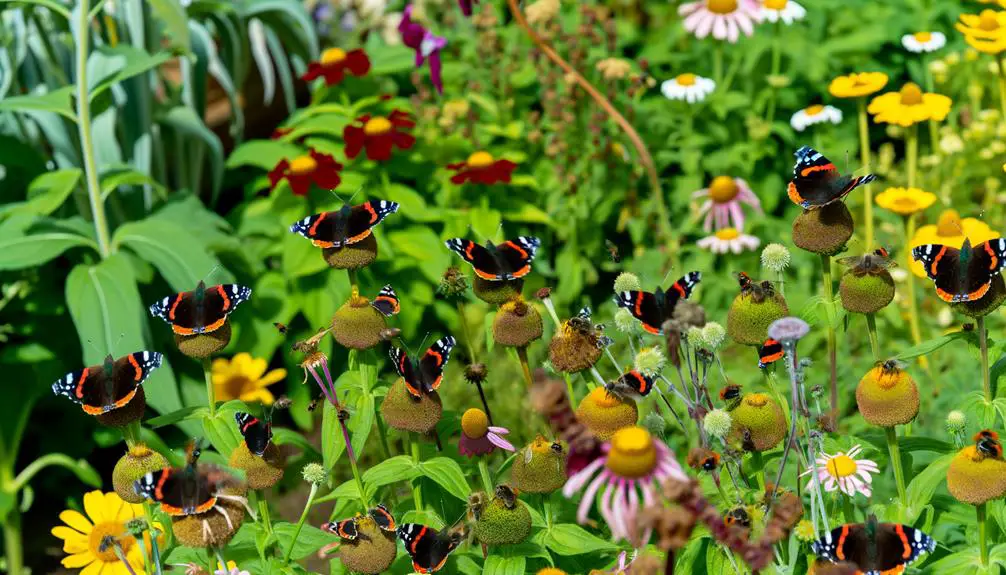Ecological Benefits of Red Admiral Butterflies
Red Admiral butterflies (Vanessa atalanta) are essential pollinators, enhancing genetic diversity in flowering plants, particularly from the Asteraceae and Lamiaceae families. Their presence indicates ecosystem health, as population dynamics reflect environmental changes such as climate shifts and habitat fragmentation.
They contribute to biodiversity by supporting food webs and aiding nutrient cycling through larval and adult stages. Migration patterns illustrate impacts of global warming, serving as bioindicators.
Conserving Red Admirals guarantees ecosystem stability and resilience. For a deeper understanding of their ecological significance, further exploration is beneficial.

Benefits of Red Admiral Butterflies
Pollination Powerhouse

The Red Admiral butterfly (Vanessa atalanta) plays a crucial role in ecosystems as an effective pollinator, facilitating the reproduction of various flowering plant species.
This Lepidoptera species exhibits a pronounced affinity for nectar-rich flowers, including those of the Asteraceae and Lamiaceae families.
Through frequent and varied floral visits, Red Admirals guarantee cross-pollination, enhancing genetic diversity and resilience in plant populations.
Empirical studies highlight their contribution to pollination networks, particularly during late summer and autumn when other pollinators are less active.
Observational data indicate their proboscis adeptly probes deep corollas, transferring pollen efficiently.
These butterflies, by visiting multiple flowers in a single foraging trip, greatly augment the reproductive success of native flora, underpinning ecological stability and biodiversity.
Environmental Indicators
Red Admiral butterflies serve as valuable environmental indicators, reflecting the health and changes within their habitats through their population dynamics and distribution patterns.
Researchers utilize these butterflies to monitor ecosystem stability, as fluctuations in their numbers often correlate with environmental stressors such as climate change and habitat destruction. Detailed observations have revealed that Red Admirals are sensitive to temperature variations, making them effective bioindicators for climate studies.
| Indicator | Observation | Environmental Implications |
|---|---|---|
| Population Density | Significant decreases noted in urban areas | Habitat fragmentation |
| Migration Patterns | Altered timing and routes observed | Climate change impact |
| Reproductive Rates | Decline in larval survival rates | Pesticide exposure |
| Distribution Range | Contraction towards cooler regions | Global warming |
Evidence-based studies confirm that Red Admirals provide critical insights into environmental health.
Supporting Biodiversity

Promoting the proliferation of Red Admiral butterflies contributes greatly to enhancing biodiversity within their ecosystems. These lepidopterans play a pivotal role in various ecological interactions, fostering rich and vibrant habitats.
- Pollination services: Red Admirals aid in the pollination of numerous plant species, ensuring genetic diversity and plant reproduction.
- Food web support: They serve as prey for birds, amphibians, and other predators, thereby sustaining trophic dynamics.
- Habitat indicator: Their presence signals a healthy environment, rich in host plants and nectar resources.
- Nutrient cycling: Through their larval and adult stages, they contribute to the decomposition process, enriching soil quality.
Evidence underscores their ecological significance, highlighting the necessity to conserve and support these butterflies to maintain ecosystem stability.
Climate Change Insights
Climate change profoundly impacts the phenology, distribution, and survival rates of Red Admiral butterflies, offering critical insights into broader ecological shifts.
Phenological changes, such as earlier emergence and prolonged flight periods, have been documented, correlating with rising temperatures.
Geographic distribution patterns are also shifting, with Red Admirals increasingly observed in previously cooler northern regions, indicative of broader range expansions.
Survival rates are influenced by altered precipitation patterns and habitat availability, often resulting in population fluctuations.
These observations provide empirical evidence of climate-induced ecological changes, making the Red Admiral an essential bioindicator for monitoring environmental health.
Understanding these dynamics aids in predicting future biodiversity responses and informs conservation strategies amidst the accelerating pace of climate change.
Enhancing Ecosystems

Examining the role of Red Admiral butterflies in enhancing ecosystems reveals their contributions to pollination, nutrient cycling, and biodiversity maintenance, which are increasingly essential as climate-induced changes reshape ecological balances.
These butterflies engage in activities that support fundamental ecological processes:
- Pollination: Red Admirals transfer pollen between flowers, facilitating reproductive success in various plant species.
- Nutrient Cycling: Their larvae feed on plant material, accelerating decomposition and nutrient recycling within the soil.
- Predator-Prey Dynamics: Serving as prey for birds and other predators, they help sustain food webs.
Such contributions underscore the importance of conserving Red Admirals to maintain resilient and functional ecosystems.
Conclusion
The study of red admiral butterflies reveals their multifaceted contributions to ecosystems.
As pollination powerhouses, they considerably aid in plant reproduction. Their presence serves as critical environmental indicators, reflecting ecological health.
By supporting biodiversity, they enhance ecosystem resilience. Observations of their behavior and distribution offer valuable insights into climate change impacts.
Consequently, red admiral butterflies not only enrich natural habitats but also provide essential data for understanding and mitigating environmental challenges. Their population trends can serve as indicators of climate change, helping scientists track shifts in temperature and habitat conditions. Additionally, studying male vs female red admiral behavior provides insights into mating patterns and territorial dynamics, which are crucial for conservation efforts. By monitoring these butterflies, researchers can develop strategies to protect both the species and the ecosystems they inhabit.







безопасная сделка аккаунтов маркетплейс аккаунтов
продажа аккаунтов платформа для покупки аккаунтов
маркетплейс аккаунтов соцсетей платформа для покупки аккаунтов
безопасная сделка аккаунтов маркетплейс аккаунтов
биржа аккаунтов магазин аккаунтов
маркетплейс аккаунтов платформа для покупки аккаунтов
услуги по продаже аккаунтов профиль с подписчиками
магазин аккаунтов социальных сетей безопасная сделка аккаунтов
гарантия при продаже аккаунтов биржа аккаунтов
продать аккаунт https://magazin-akkauntov-online.ru
магазин аккаунтов безопасная сделка аккаунтов
магазин аккаунтов социальных сетей гарантия при продаже аккаунтов
услуги по продаже аккаунтов гарантия при продаже аккаунтов
аккаунт для рекламы https://pokupka-akkauntov-online.ru/
Account Purchase Account Market
Account Catalog Database of Accounts for Sale
Gaming account marketplace Accounts marketplace
Account Purchase Account marketplace
Buy accounts Secure Account Sales
Guaranteed Accounts Accounts marketplace
Sell Account Marketplace for Ready-Made Accounts
Verified Accounts for Sale Marketplace for Ready-Made Accounts
Buy accounts Website for Buying Accounts
Website for Buying Accounts https://buyaccounts001.com/
Website for Buying Accounts Marketplace for Ready-Made Accounts
account exchange service account exchange
account trading service profitable account sales
account store account trading platform
buy and sell accounts account trading platform
website for buying accounts account purchase
accounts market buy and sell accounts
accounts market https://socialaccountsdeal.com/
account buying platform account trading
sell accounts sell pre-made account
database of accounts for sale account store
account trading service account market
guaranteed accounts secure account purchasing platform
secure account purchasing platform buy accounts
account acquisition buy and sell accounts
social media account marketplace account purchase
account trading platform account acquisition
account purchase account catalog
website for buying accounts guaranteed accounts
account trading platform account market
website for buying accounts sell pre-made account
sell account account selling platform
buy accounts sell account
account acquisition account trading service
accounts market buy account
profitable account sales account purchase
account selling platform buy pre-made account
account marketplace account buying service
social media account marketplace account selling platform
gaming account marketplace https://accounts-offer.org
marketplace for ready-made accounts accounts marketplace